The Surface 3 Review
by Brett Howse on May 4, 2015 9:00 AM ESTDisplay
When Surface Pro 3 moved to a 3:2 aspect ratio, it made a lot of sense. 16:9 in a tablet makes for a very poor experience, and in a laptop, it is not much better. Almost everyone has moved to 16:9 in the laptop space and the lack of vertical height can make for a less than ideal experience. Most web content is vertical, and working in Office means you want vertical space as well. The widescreen does help with two windows snapped open at once, but I always find myself craving more vertical room.
On a tablet, I feel that 16:9 is even worse. Holding a 16:9 device in one hand can feel very heavy due to the length of the tablet, and turning it to portrait means that it is very tall and skinny. The move to 3:2 really squares up the device, and makes it a lot more balanced in either direction. Holding it in one hand is much easier, and finally portrait mode is usable on the Surface.
So the aspect ratio is a big improvement. The display size also has a slightly wider corner to corner of 10.8 inches versus 10.6 inch model that came before this. The actual width of the display is about 9 inches, compared to 9.2 on the outgoing Surface 2 model. The display height is now 6 inches, up from 5.2, so the total area of the display is almost 54 square inches, up from 48 inches on the outgoing model.
To fill this display, we have a Panasonic panel with a resolution of 1920x1280. This is roughly the same pixel density as the Surface Pro 3’s slightly larger 12 inch 2160x1440 display, coming in at 217 pixels per inch. It is not the highest PPI of a tablet, but it makes a good compromise between desktop and tablet use. Speaking of desktop use, I found that it makes a perfectly acceptable size for a small notebook, and even with touch it was not too difficult to work with the icons.
When Microsoft launched Surface 3, it said “with incredibly accurate colors and clarity from multiple viewing angles” and that would be excellent to see. The Surface Pro 3 has a decent display, but it was not the most accurate device we’ve tested.
To do our display testing, we use SpectraCal’s CalMAN 5 suite with a custom workflow. Brightness and contrast readings are taken with an X-Rite i1Display Pro colorimeter, and color accuracy is measured with an X-Rite i1Pro spectrophotometer. We target 200 nits brightness when doing our tests.
Brightness and Contrast
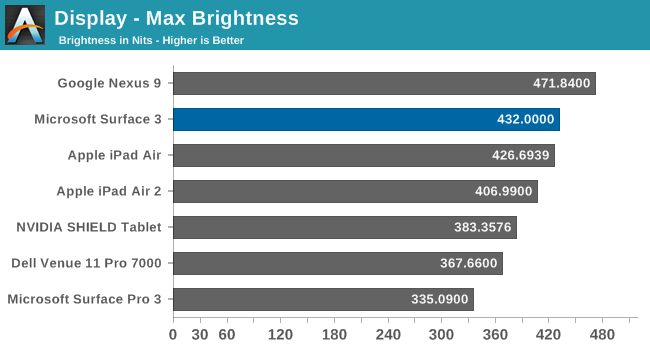
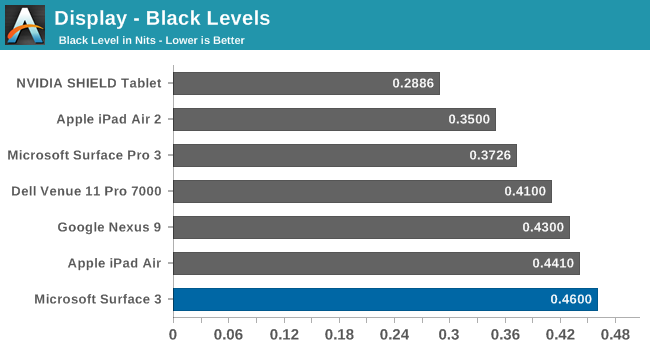
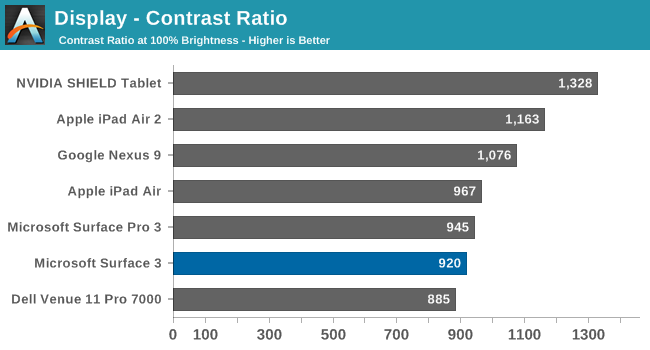
The Surface 3 gets quite bright, coming in at 432 nits at maximum output. The black levels are a bit high, but overall contrast is a decent 920:1. This makes the Surface 3 almost 100 nits higher than the Surface Pro 3 that Anand reviewed last year, which is a good start for this less expensive version.
Grayscale
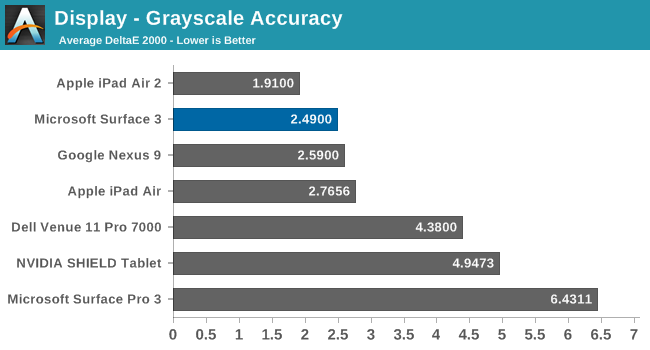
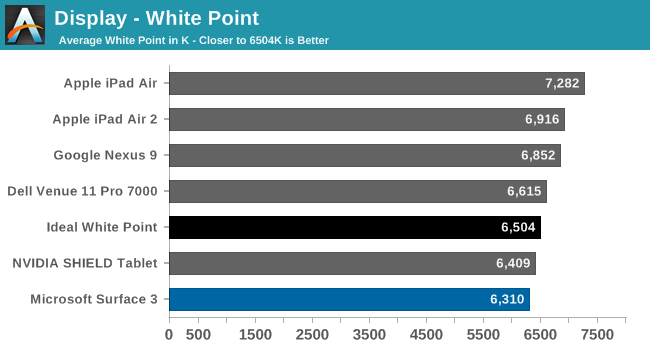
The grayscale average for the Surface 3 is very good, coming in just about at 2.5 as an average for the sweep. There is a bit of a spike at 25% but it is not indicative of the overall calibration. Gamma is a bit low, but the white point is fairly close to the ideal value.
Saturation
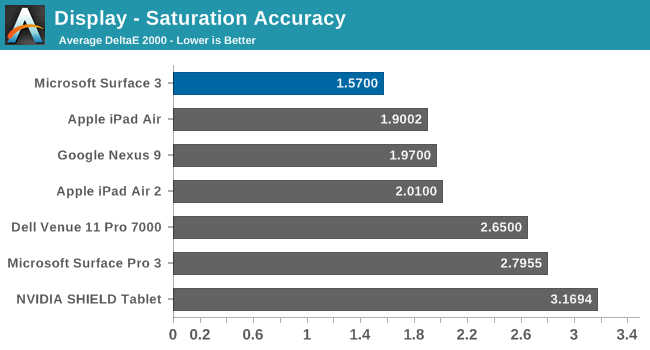
The accuracy on our saturation tests is outstanding, with an overall average score of just 1.57. Looking at the individual colors, the red is a bit oversaturated at 100%, and blue tends to be undersaturated, but the amount of error is very small.
Gamut and Gretag Macbeth
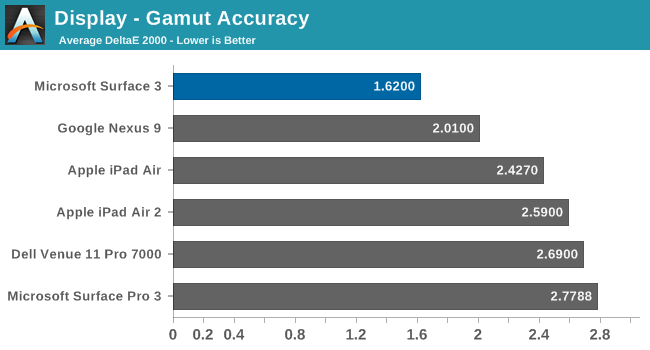
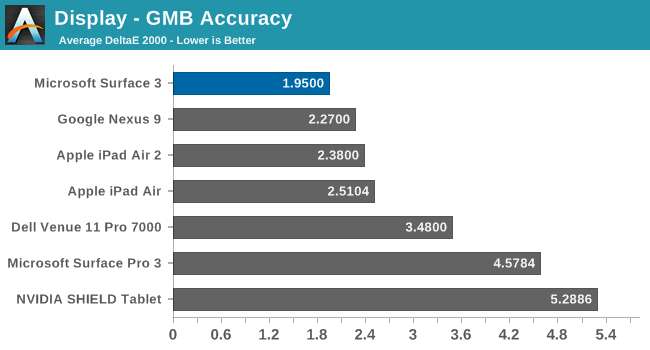
Once again the Surface 3 comes in with fantastic scores on these two tests, with the comprehensive GMB test under 2. When we are doing these tests, values under 3 are considered good, and the Surface 3 has passed with amazing scores. The best part of this is that all of this is done without the use of an ICC profile, so that means the hardware is being calibrated directly. ICC profiles can fix some issues, but not all programs respect them so having it done in hardware is a much better option.
Calibrated
Since this is a full x86 Windows operating system, we can also calibrate the display with the CalMAN software. Even though it was very good out of the box, the calibration pulls it even closer to perfection.
Surface 3 has one of the most accurate displays we have ever tested, which is great to see in what is considered the value member of the Surface family. Microsoft promised an accurate display and they have delivered.


















265 Comments
View All Comments
extide - Monday, May 4, 2015 - link
Yeah, but that is only sequential -- in random I/I the eMMC will still beat the pants off a regular laptop hdd -- and that's what really matters.lilmoe - Monday, May 4, 2015 - link
Wouldn't you think that random speed not only makes up for that, but also makes it seem much faster in real life scenarios compared with HDDs?Anyway, UFS should make the gap much wider in future products. Samsung and others are working on super cheap modules. SSDs aren't needed in most segments.
magreen - Monday, May 4, 2015 - link
Yes, it is better in random access than a cheap laptop HDD. But I don't know if that's the only thing that matters. It's unbalanced, just like the early SSDs were. The early SSDs were unreasonably slow in random write, and this is unreasonably slow in sequential write.As to which is more essential to feel "fast," I think that may be in the eye of the beholder. Yes, this eMMC may have some snappiness to it due to quickness in random access, so it won't get slowed to a clickety-clackety crawl by a virus check, for example. But it's probably painfully slow to complete tasks we're not accustomed to waiting for (sequential). That may be what the reviewer is pointing out, that storage seemed to be a bottleneck.
68k - Wednesday, May 6, 2015 - link
Mechanical HD and eMMC is not even at the same level when it comes to which feel "faster". Random access is far more important for everyday use, which make eMMC superior in very close to 100% of the use cases.Random access performance of small sizes at low queue depth is what a disk targeting interactive usage should optimize for.
magreen - Wednesday, May 6, 2015 - link
Really? For a full-blown Windows install? How would you know?You're not making a fair comparison. Remember this thing runs full Windows 8.1. The whole purpose is that people can use their standard desktop applications. You can't just think of the speedup from a typical HDD to a typical SSD. You'd have to cripple the sequential access to make the assessment.
When was the last time you used an external SSD over USB 2.0 as your boot and programs install drive, to test your hypothesis? Or how about a microSD card as your boot drive? How slow would it be to fire up Microsoft Word? How about opening up a large video file? What about a file copy? You're not used to waiting for the sequential aspects of any of those because they're almost always >100MB/s, even on a cheapo 5400 rpm HDD.
jabber - Tuesday, May 5, 2015 - link
33MBps but far far lower latency which I find more effective/noticable than raw MBps. The average user won't be overly concerned.Too many of us here have just been spoilt.
tim851 - Monday, May 4, 2015 - link
I don't know, man. Here in Germany the Surface 3 64 GB is 10% more expensive than the iPad Air 2 with 64 GB. And I would never call an iPad 'good value', though it will likely hold its value better than the Surface.The Surface has the perk of running full Windows, but without a keyboard, I don't see anybody getting much use out of the desktop.
I personally still find the S3 pretty enticing, if only for the Stylus, which is another Apple-priced add-on. But I would call it good value, not to speak of "best value".
lilmoe - Monday, May 4, 2015 - link
Ok, but how many tablets do you know can do what the Surface 3 can at that price?I do agree that the accessories are on the overpriced side, but don't forget that they aren't the only accessories that work with this device, and it doesn't *need* them to deliver on its promise. I personally wouldn't be using it as a "laptop replacement" on the go, but at home or in the office, I'd connect it to a bluetooth/wireless mouse/keyboard and an external monitor if necessary...
This device works great for any type of media consumption since it's capable of running/viewing just about anything. It's also great for Office at home, or for your average secretary, assistant, HR, and sales employee for work. It's one of a kind device for these purposes.
Manch - Monday, May 4, 2015 - link
I have an original PRO and I use onenote on it religiously. Its replaced paper notebooks for me. I'm actually thinking about getting the S3. The pen is awesome. Marking up docs is great. Hand writing rec even works on my writing and I write right handed now bc of an injury. whether I'm at a tech conference or just at work, the device is awesome. My buddy has the S3 Pro and I drool about getting one. Thing is I have the dock, keyboard and what not already so I'm reluctant to buy again. I dont however need the power I have in the PRO. The regular S3 would work great.Manch - Monday, May 4, 2015 - link
I forgot to add, I dont see the desktop much on the PRO. I use it in tablet mode. Keyboard only gets snapped to it when i'm on the road bc its more than enough computing power. At my desk when docked i have an external monitor and kb mouse. With Windows 10 on it now, wow, so much better!